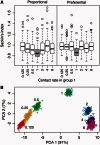Phylodynamic Inference with Kernel ABC and Its Application to HIV Epidemiology
- PMID: 26006189
- PMCID: PMC4540972
- DOI: 10.1093/molbev/msv123
Phylodynamic Inference with Kernel ABC and Its Application to HIV Epidemiology
Abstract
The shapes of phylogenetic trees relating virus populations are determined by the adaptation of viruses within each host, and by the transmission of viruses among hosts. Phylodynamic inference attempts to reverse this flow of information, estimating parameters of these processes from the shape of a virus phylogeny reconstructed from a sample of genetic sequences from the epidemic. A key challenge to phylodynamic inference is quantifying the similarity between two trees in an efficient and comprehensive way. In this study, I demonstrate that a new distance measure, based on a subset tree kernel function from computational linguistics, confers a significant improvement over previous measures of tree shape for classifying trees generated under different epidemiological scenarios. Next, I incorporate this kernel-based distance measure into an approximate Bayesian computation (ABC) framework for phylodynamic inference. ABC bypasses the need for an analytical solution of model likelihood, as it only requires the ability to simulate data from the model. I validate this "kernel-ABC" method for phylodynamic inference by estimating parameters from data simulated under a simple epidemiological model. Results indicate that kernel-ABC attained greater accuracy for parameters associated with virus transmission than leading software on the same data sets. Finally, I apply the kernel-ABC framework to study a recent outbreak of a recombinant HIV subtype in China. Kernel-ABC provides a versatile framework for phylodynamic inference because it can fit a broader range of models than methods that rely on the computation of exact likelihoods.
Keywords: approximate Bayesian computation; human immunodeficiency virus; molecular epidemiology; phylodynamics; tree shape; virus evolution.
© The Author 2015. Published by Oxford University Press on behalf of the Society for Molecular Biology and Evolution.
Figures




Similar articles
-
Inference of Transmission Network Structure from HIV Phylogenetic Trees.PLoS Comput Biol. 2017 Jan 13;13(1):e1005316. doi: 10.1371/journal.pcbi.1005316. eCollection 2017 Jan. PLoS Comput Biol. 2017. PMID: 28085876 Free PMC article.
-
Phylodynamic Inference across Epidemic Scales.Mol Biol Evol. 2017 May 1;34(5):1276-1288. doi: 10.1093/molbev/msx077. Mol Biol Evol. 2017. PMID: 28204593 Free PMC article.
-
Phylodynamic inference and model assessment with approximate bayesian computation: influenza as a case study.PLoS Comput Biol. 2012;8(12):e1002835. doi: 10.1371/journal.pcbi.1002835. Epub 2012 Dec 27. PLoS Comput Biol. 2012. PMID: 23300420 Free PMC article.
-
On the use of kernel approximate Bayesian computation to infer population history.Genes Genet Syst. 2015;90(3):153-62. doi: 10.1266/ggs.90.153. Genes Genet Syst. 2015. PMID: 26510570 Review.
-
HIV evolutionary dynamics within and among hosts.AIDS Rev. 2006 Jul-Sep;8(3):125-40. AIDS Rev. 2006. PMID: 17078483 Review.
Cited by
-
Impacts and shortcomings of genetic clustering methods for infectious disease outbreaks.Virus Evol. 2016 Oct 20;2(2):vew031. doi: 10.1093/ve/vew031. eCollection 2016 Jul. Virus Evol. 2016. PMID: 28058111 Free PMC article.
-
Reconstructing contact network parameters from viral phylogenies.Virus Evol. 2016 Oct 30;2(2):vew029. doi: 10.1093/ve/vew029. eCollection 2016 Jul. Virus Evol. 2016. PMID: 27818787 Free PMC article.
-
Inferring epidemiological parameters from phylogenies using regression-ABC: A comparative study.PLoS Comput Biol. 2017 Mar 6;13(3):e1005416. doi: 10.1371/journal.pcbi.1005416. eCollection 2017 Mar. PLoS Comput Biol. 2017. PMID: 28263987 Free PMC article.
-
Phylodynamic Model Adequacy Using Posterior Predictive Simulations.Syst Biol. 2019 Mar 1;68(2):358-364. doi: 10.1093/sysbio/syy048. Syst Biol. 2019. PMID: 29945220 Free PMC article.
-
Predicting the short-term success of human influenza virus variants with machine learning.Proc Biol Sci. 2020 Apr 8;287(1924):20200319. doi: 10.1098/rspb.2020.0319. Epub 2020 Apr 8. Proc Biol Sci. 2020. PMID: 32259469 Free PMC article.
References
-
- Aizerman A, Braverman EM, Rozoner LI. 1964. Theoretical foundations of the potential function method in pattern recognition learning. Autom Remote Control. 25:821–837.
-
- Blum MGB, François O. 2005. On statistical tests of phylogenetic tree imbalance: the Sackin and other indices revisited. Math Biosci. 195:141–53. - PubMed
-
- Colless DH. 1982. Review of “Phylogenetics: the theory and practice of phylogenetic systematics.” Syst Zool. 31:100–104.
Publication types
MeSH terms
Grants and funding
LinkOut - more resources
Full Text Sources
Other Literature Sources
Medical

